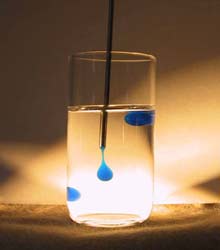Nov
12
Ionic Liquids For Your Air Battery
November 12, 2009 | 2 Comments
An Arizona State University spin off, Fluidic Energy in Scottsdale, AZ, was awarded a U.S. Department of Energy research grant of $5.13 million at the end of October 2009. Fluidic Energy says it can develop a metal-air battery that dramatically outperforms the best lithium-ion batteries on the market. Now the company has the cash coming it needs to prove it.
The money goes to developing a metal-air battery that relies on ionic liquids, instead of an aqueous solution, as its electrolyte. Ionic liquids essentially are salts that are liquid at room temperature, and which often can remain a liquid in sub-zero temperatures or above the boiling point of water.
The U.S. Air Force Academy about 25 years ago to work out the problem of water in the electrolytes can evaporate, causing the batteries to prematurely fail and that water also has a relatively low electrochemical window, meaning it will begin to decompose when the cell exceeds 1.23 volts. By the early 1980s the Academy experimented with ionic liquids.
John Wilkes, an ionic liquids expert who heads the Academy’s chemistry department says in a quote from Tyler Hamilton’s article in Technology Review, “They’re wonder fluids. They’re remarkable. If you look at these liquids in a bottle, they look like water, except they’re viscous. They’re not volatile, they don’t evaporate, they’re physically stable and they conduct electricity fairly well.”
That is a clue for the metal air battery community, both zinc and lithium that typically rely on water-based electrolytes. Oxygen from ambient air is drawn in through a porous “air” electrode (-cathode) and produces hydroxyl ions on contact with the electrolyte. These ions reach the anode and begin to oxidize the metal, a reaction that produces current through the release of the electrons. No evaporation and no oxidation would be a wonderful attribute.
Cody Friesen a founder of Fluidic Energy and a professor of materials science at Arizona State says the use of ionic liquids overcomes many of the problems that have held back metal-air batteries in the past says, “I’m not claiming we have it yet, but if we do succeed, it really does change the way we think about storage,”
Freisen’s ASU team has a few years under their belt experimenting with various ionic liquids. They’ve learned a metal-air battery using an ionic liquid as its electrolyte not only functions significantly longer, because drying out is no longer a problem, but ionic liquid batteries also get a big boost in energy density.
Here is a gasp moment, Friesen says, “These liquids have electrochemical stability windows of up to five volts, so it allows you to go to much more energy-dense metals than zinc.” The team plans will target energy densities of at least 900 watt-hours per kilogram and up to 1,600 watt-hours per kilogram in the DOE-funded project. Now that’s rich battery energy density, very rich indeed.
University of Alabama Professor of Chemistry Robin Rogers says the challenge is finding “commodity ionic liquids” with the right set of properties that can completely change the economic equation for metal-air batteries. “It’s not impossible,” he says. “I look at ionic liquids and say, take a step back, because you need to do it in a completely different way.”
Wilkes also addresses the availability problem that Friesen’s team will need to work out. Ionic liquids are still made in small quantities, making them expensive compared to many other solvents used to dissolve salts. But Wilkes also know that, “But some people are making ionic liquids now out of things that are already known and produced in high quantities, like detergents.”
Undeterred, Friesen downplays the cost concern, pointing out that the liquids become quite economical when developed in-house in large volumes.
Covering the proprietary matters Friesen is careful not to say too much about the ionic liquids his team has developed, revealing only that there are “several contenders that seem to work well.”
The other matter that haunts the metal air community is the problem of dendrite formation on the metal films. Friesen is hinting in the interview that their metal electrode structure overcomes the dendrite formation problem. Dendrite formation occurs in rechargeable batteries when the chemical reactions are reversed, limiting the number of charging cycles with branching structures that short circuit electrodes.
Reports have it that Fluidic Energy has developed an electrode scaffold with multi-modal porosity, meaning the range of pore sizes is down to as small as 10 nanometers. The scaffold surrounds the metal, in the example of zinc, and can prevent dendrites from forming during charging.
The DOE and Friesen know they’re on to something with the possible solutions to eliminate water and its evaporation, boost voltage by 3 fold and more, and eliminate the dendrite formation. Friesen says, “We’re working now on taking it to the next level. It’s about taking everything we’ve done over the last four years and leveraging that work into a battery that looks and feels just like a lithium battery, but has energy densities far beyond that.”
Should these developments make it to market with the attributes in tact or better, energy storage in batteries would have much broader applications. The performance increases could take personal transport ranges out to perhaps 500 miles, reduce the weight and the cost. Friesen allows all that, “at a cost just a little over lead-acid batteries.”
Its just enough progress to put a little well placed confidence in batteries. It’s just enough to serve notice to Eestor to get control of those prices before they hit the market with their ultra capacitor. The hint is also there that the batteries could work well across a wide range of climates and temperatures.
The story so far also leaves a question – just what energy denser metals are they experimenting with?
Comments
2 Comments so far



Couldnt agree more with that, very attractive article
Good Article, i’ve never think of that.